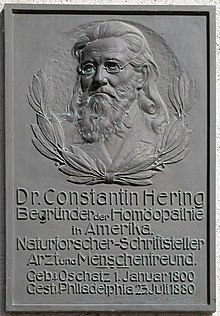Constantin Hering
Constantin Hering (born January 1, 1800 in Oschatz , Electorate of Saxony , † July 23, 1880 in Philadelphia , USA ) was a German-American doctor. He was one of thirteen children of his parents Carl Gottlieb Hering and Christiane Friderike and is considered the founder of homeopathy in America.
Career
He began his medical studies in Leipzig , in 1826 he received his doctorate in Würzburg with the thesis De Medicina futura (The Medicine of the Future). As a student, Hering was commissioned to write a treatise on the “wrong path” of homeopathy. After studying the matter for two years, he eventually became an enthusiastic advocate of the healing method. After graduation, he began to travel, joined an expedition to South America and stayed in Suriname from 1827 to 1833 . There he was the governor's personal physician , looked after a hospital and a leper colony, and carried out drug tests , best known including testing the venom of the South American Bushmaster snake species ( Lachesis muta , named after the ancient goddess Lachesis ) (published in Stapf's archive ). After a short stay at home, he traveled to Philadelphia in the United States in 1833 and stayed there intermittently. He helped found the American Institute of Homoeopathy (1844), the Homoeopathic Medical College of Pennsylvania (1848) and the Hahnemann Medical College of Philadelphia (1867).
Hering is credited with introducing snake poisons and the term “ nosode ” into the homeopathic materia medica . He is also responsible for many other innovations in homeopathy, such as: B. the observation of disease or healing processes (called Hering's rule or Hering's law), the single-glass method, potentizing with water, the dilution ratio of 1:10, testing of new chemical compounds (e.g. nitroglycerine , called Glonoinum in homeopathy ) . In 1845 he described for the first time the testing of Acidum fluoricum (hydrofluoric acid) in homeopathic dilution.
Constantin Hering was the father of Rudolph Hering , the founder of modern environmental technology . Three of his better-known siblings were Carl Eduard Hering , Ewald Hering (pseud. Ewald) and Julius Robert Hering .
Hering's rule
Hering's rule is an assessment criterion for the course of treatment, according to which, in homeopathic treatment, the symptoms of a chronic illness move from "top to bottom" and "from inside to outside", ie. H. from "more vital to less vital organs" should improve. Hering's rule, along with the law of similars, is one of the most important homeopathic theories. Some homeopaths such as B. Georgos Vithoulkas or James Tyler Kent it is also referred to as "Hering's Law".
Publications
- The Homoeopathist or Domestic Physician . Allentown 1835.
- Effects of snake venom / for medical use compiled by Constantin Hering for comparison . Blumer, Allentaun (Pa.) 1837 Digitized edition of the University and State Library Düsseldorf .
- Materia Medica with a Pathological Index . New York 1873.
- Analytical Therapeutics . New York 1875.
- Condensed Materia Medica . New York 1877.
- The Guiding Symptoms of Our Materia Medica . 1879-1891.
- Homeopathic family doctor. 1828. (Reprint: 1998, ISBN 3-933581-09-5 )
- Constantin Hering's homeopathic family doctor: based on the best homeopathic works and own experiences, with instructions on the way of life and reporting and a medical certificate. 17th, revised and enriched edition. Frommann, Stuttgart 1893 ( digitized edition of the University and State Library Düsseldorf ).
literature
- Klaus-Henning Gypser (Ed.): Herings medical writings. 3 volumes. Göttingen 1988, DNB 551538589 .
- R. Schüppel: Constantin Hering (1800–1880): An academic founds institutions. In: Martin Dinges (Ed.): Homeopathy. Haug, Heidelberg 1996, ISBN 3-7760-1574-8 , pp. 296-317.
- E. Cleave: Cleave's biographical cyclopaedia of Pennsylvania . 1874.
- David Little: Hering, Idem and Homoeopathy . 1998.
Individual evidence
- ↑ C. Hering: Hydrofluoric acid (Acidum fluoricum). In: E. Stapf, GW Gross (ed.): Archives for homeopathic healing art. Volume 22, Issue 1, 1845, pp. 100-185.
- ↑ Josef M. Schmidt: Pocket Atlas Homeopathy in words and pictures . Karl F. Haug Fachbuchverlag, 2001, ISBN 3-8304-7089-4 , p. 15.
- ↑ Maria-E. Lange-Ernst, Sebastian Ernst: Lexicon of Homeopathy . Naumann and Göbel, 1997, ISBN 3-625-10621-3 , p. 142.
Web links
- Literature by and about Constantin Hering in the catalog of the German National Library
- Photo of herring
- A biography by Constantin Hering
| personal data | |
|---|---|
| SURNAME | Hering, Constantin |
| BRIEF DESCRIPTION | is considered the founder of homeopathy in America |
| DATE OF BIRTH | January 1, 1800 |
| PLACE OF BIRTH | Oschatz , Saxony |
| DATE OF DEATH | July 23, 1880 |
| Place of death | Philadelphia , USA |
